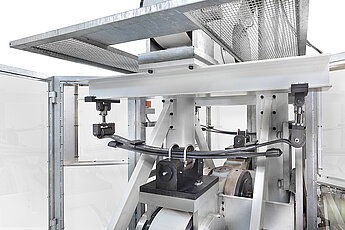- Business Fields
- Automotive
-
Springs
- Fatigue strength of axle springs
- Fatigue strength of valve springs
- Corrosion Spring Testing Machine (CSTM)
- Dry Spring Testing Machine (DSTM)
- Valve Spring Testing Machine (VSTM)
- Variable Test Rig for Resilient Components (VTRC)
- Grit Impact Simulator Machine (GISM)
- Rotating Bending Test Machines (RBTM)
- Large Spring Testing Machine (LSTM)
- Spring Coil Test Machine (SCTM)
-
Large Spring Testing Machine (LSTM)
Large Spring Testing Machine (LSTM)
The Development and Quality Monitoring of resilient, highly stressed automotive components such as springs, requires testing that represents actual vehicle conditions as accurately as possible. There are some essential test areas when determining the quality of spring steel, for example, fatigue strength and settling behavior under realistic load and environmental conditions.
Based on these requirements, IABG offers a spring test machine capable of performing fatigue tests on large resilient components under normal laboratory atmosphere. Thus allowing the determination of the fatigue strength of such components as coil and leaf springs, while reducing both time and cost.
Advantages of the IABG Large Spring Testing Machine
- Higher energy efficiency in comparison to a hydraulic system due to the utilisation of resonance principals
- The testing of larger springs with higher spring rates, or the simultaneous testing of a large amount of springs with lower spring rates
- High test frequency
- Statistical determination of load and spring length (plotting spring characteristic curves, settling determination)
- Designed to exclude all external forces and vibrations
- Reliability and low maintenance
- Software-based testing, documentation and evaluation
- Accepted by all leading car manufacturers
- Compliant with German OEM standards (AK-LH 07) of springs and stabilizer bars
Relevant influences on Springs
- Mechanical demands from
- Spring compression
- Axle kinematics
- Damage to the surface and coating through
- Abrasion caused by spring coil contact
- Stone impact
- Corrosion
Experimental verification
- Pre-damage caused by stone impact
- Corrosion in alternating cycle tests developed by the German Association of the Automotive Industry (Verband der Automobilindustrie, VDA)
- Tests with original spring seats in installation position
- Fatigue test with cyclic load with fixed or variable amplitudes
- Abrasive wear simulation
- Statistical validation through systematic testing and a sufficient number of test items
- Statistical validation with systematic testing and a sufficient number of test items
- Determination of dynamic settling
Technical data
- Test specimens:
parallel deflected springs of all types, leaf springs - Max. permissible load over both test areas:
Fmax = 200 kN - Number of springs that can be tested simultaneously: 2, 4, … limited by Fmax
- Stroke (displacement controlled): S = 10 to 400 mm
- Max. Spring length: L0 = 1000 mm
- Test frequency:
fo = 0,19 … 0,28 √(n·R) [Hz] = 2 to 20 Hz
n = Number of test specimens tested
R = Spring rate [N/mm] - Weight / Measurement of machine:
8,5 tons, L = 2200 mm, W = 2200 mm,
H = 3500 mm (additional space required for:
control panel and hydraulic aggregate)
